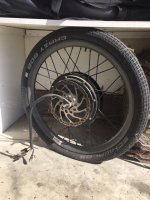For me several reasons,
The main one is that I started out 5 years ago with a high speed low torque hub motor ( Mac 6T ) and live in a very hilly area , with a couple mountains near by.
and
I wanted to try out different voltage battery packs because sometimes I want to go fast ,
sometimes go up a hill slower .
I did go up a long and steep hill with the Mac 6t , at different throttle stettings , on a 48 volt ( 13s pack ) and it melted solder in the motor and I had to get the motor fixed .
Then
My budget only allows a couple of hundred dollars at a time for batteries , so around 4 years ago Hobby King would have sales on Lipo battery packs. I would buy 6s , for a 12s pack and 7s for a 14s pack and 2 8s packs for 16s , each at different times over the course of 3.5-4 years .
In the last year I bought 4 5s packs to experiment with , so I can do 10s or 20s
( I tried 20s on my mid drive/30 amp controller up a long steep mountain and it did not work well , even using lower gearing . )
With 4 different size packs , I want to get use out all of them.
Note : I have been watching Hobby King regularly and for the last nearly year there have been No , sales on packs that are 5000mAh or larger . And Prices have gone up on other items there , so perhaps Cheeper Lipo packs are more rare these days .
For me going up hills on lower throttle settings just does not work, the motor bogs down much faster that way.
Perhaps it would work like you say if I were to buy controllers that go over 30 amps ? even the 40 amp controller that I had with the Mac 6t , although to save the motor I had the Cycle Analyst set to 35 amps max.
Now that that is sold and I am using a DD rear , and Mid Drive I want to modify the 30 amp controllers to get more amps out of them.
amberwolf said:
? @scooterman101
why not just use the higher voltage battery and lower throttle to get the same motor operation you would get from a lower voltage battery?
i can't understand what you would get by actually swapping batteries simply to get a higher or lower voltage to get a higher or lower motor speed.
the controller converts the one to the other based on your throttle usage and whatever it's programming is so it is completely unnecessary.



